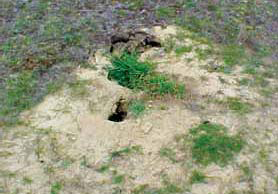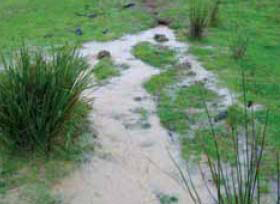Development on land that consists of dispersive soils can result in tunnel erosion and consequential damage to private property, public infrastructure, and environmental harm. Tunnel erosion results in the formation of underground cavities that can collapse causing subsurface erosion. Tunnel erosion is difficult to repair and therefore it is important to avoid initiating tunnel erosion through appropriate design and construction techniques.
This Information sheet is intended to present a brief overview of this issue and is a summary of a comprehensive reference source “Dispersive soils and their management: Technical Reference Manual” available at www.dpipwe.tas.gov.au.
Dispersive soils are also known as sodic soils and sodosols and are often derived from Triassic sandstone or Permian Mudstone geology. In contact with water, excessive sodium in soils can attach to clay forcing clay particles apart. In the process, dispersed clay particles can clog up the small pores in the soil degrading soil structure and affecting water movement and root growth.
Dispersive soils can be identified by dribble patterns and pitting (Fig. 1) and early stages of tunnel erosion can be identified by ‘spew holes’ and fans of dispersed material ejected from tunnels (Fig. 2 & 3). Dispersion is often evident in muddy or milky water in dams.
source: dispersive soils and their management – guidelines for landholders, planners and engineers www.dpipwe.tas.gov.au
Testing for dispersive soils
A simple test to identify the presence of dispersive soils is detailed in “Dispersive soils and their management: Technical Reference Manual” and consists of collecting and drying the soil and then observing how the soil changes once placed in distilled / rain water.
Activities that increase risk of tunnel erosion
Tunnel erosion is generally caused by site disturbance allowing rainwater to come into direct contact with dispersive subsoils. The risk of exposing dispersive subsoils to direct contact with rainfall include;
- removal of topsoil,
- subsoil excavations (cut and fill) or for trenches for services such as telecommunications,
- construction of roads, culverts and driveways,
- sewage and grey water disposal systems, and
- changes to surface water flows, concentrating runoff from hardstand areas, construction of culverts or dam construction.
Reducing risk associated with dispersive soils
The risk of initiating tunnel erosion during construction or development of land containing dispersive soils can be minimised by:
- identifying and avoiding disturbance to areas with dispersive subsoils,
- minimising excavation of dispersive soils through appropriate construction techniques such as pier footings rather than cut and fill to achieve concrete slab footings,
- minimising or avoiding the use of trenches and where this is not possible ensure that repacked soil is compacted, treated with gypsum, covered with topsoil and re-vegetated,
- not allowing water to pond on the soil surface, or exposed subsoils and directing runoff to areas with no dispersive soils,
- keeping dispersive soils buried under topsoil,
- using above ground on-site wastewater disposal systems rather than septic systems,
- maintaining vegetation cover, and
applying gypsum or hydrated lime at appropriate rates which modifies the chemical composition of the soil and may limit the extent of dispersion.
Rehabilitation of tunnel erosion
Land subject to tunnel erosion can be repaired with appropriate techniques detailed in Dispersive soils and their management: Technical Reference Manual”
How do I know if my land is prone to tunnel erosion hazard?
The following map shows areas that may be prone to tunnel erosion. It is an indicative map only and cannot be relied upon for detailed site planning. This mapping forms the basis for the application of the Dispersive Soils Overlay shown on the planning scheme maps. It is divided into areas of Minor and Severe risk.
You can view the areas identified as being susceptible to dispersive soils at www.iplan.tas.gov.au or alternatively contact Council’s Customer Service Office.
SOURCE: Dispersive soils and their management: Technical Reference Manual – www.dpipwe.tas.gov.au
Planning Scheme requirements
The Dispersive Soils Code (E.21.0) of the Huon Valley Interim Planning Scheme 2015 requires any development proposal located within an area mapped as being prone to dispersive soils to be accompanied with a Soil Management Plan. Such a Plan will be required to be prepared by a suitably qualified geologist or soil scientist and have regard to the following:
- the dispersive potential of soils in the vicinity of the proposed buildings, driveways, services and the development area generally;
- the potential of the development to affect or be affected by erosion, including gully and tunnel erosion;
- the dispersive potential of soils in the vicinity of water drainage lines, infiltration areas / trenches, water storages, ponds, dams and disposal areas;
- The level or risk and potential consequences for property and the environment from potential erosion, including gully and tunnel erosion;
- Management measures that would reduce risk to an acceptable level.
Further information
In addition to dispersive soil hazard the land may also be prone to landslip hazard. You may wish to review a separate information sheet on ‘Unstable Land’




